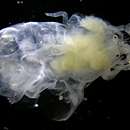Comprehensive Description
provided by Smithsonian Contributions to Zoology
Paratypton siebenrocki Balss, 1914
Paratypton siebenrocki Balss, 1914a:84, fig. I [type locality: “Senafir,” “Koseir,” and “Sherm Sheikh,” Red Sea; Jaluit, Marshall Islands; and Samoa].—Bruce, 1969d:172, figs, 1–5.pl. 1; 1983c:897.
DIAGNOSIS.—Characters of genus; maximum postorbital carapace length 4.1 mm.
RANGE.—See “Range” of the genus.
*Periclimenaeus Borradaile, 1915
Periclimenaeus Borradaile, 1915:207 [type species, selected by Borradaile, 1917:378: Periclimenaeus robustus Borradaile, 1915:213; gender: masculine].
DIAGNOSIS.—Rostrum well developed, usually overreaching anteriorly extended eyes, compressed laterally, armed at least dorsally throughout length, lateral carina not expanded into broad supraocular or postocular eave; carapace slightly compressed, dorsal profile straight or slightly convex, with or without 1 or more teeth of dorsal rostral series continuing onto gastric region, anterior margin not produced anteroventrally as prominent convex lobe and not deeply concave (notched), without longitudinal branchiostegal suture, with antennal spine, without hepatic spine, orbital margin often interrupted posteriorly; telson not curving ventrad, posterior margin not incised, median and submedian pairs of posterior spines not curving ventrad, dorsolateral spines not particularly robust; antennal scale well developed; mandible without palp; 3rd maxilliped with exopod; 4th thoracic sternite without slender median process; 1st pereopod with carpus entire, not subdivided; 2nd pereopods dissimilar and unequal, fingers of major chela with socket and plunger closure; 3rd pereopod composed of 7 or 8 segments, merus and ischium not fused; uropod with at least one fixed lateral tooth on lateral branch, accompanied by at least one movable spine mesial thereto.
RANGE.—Red Sea and South Africa to Japan, Indonesia, and Australia, and eastward to Hawaii and Pacific coast of America from Costa Rica to Colombia and western Atlantic from North Carolina and Bermuda to Panama and Trinidad; associated with sponges, alcyonarians, and ascidians, from shallow water to 370+ meters.
- bibliographic citation
- Chace, Fenner Albert, Jr. and Bruce, A. J. 1993. "The caridean shrimps (Crustacea: Decapoda) of the Albatross Philippine Expedition 1907-1910, Part 6: Superfamily Palaemonoidea." Smithsonian Contributions to Zoology. 1-152. https://doi.org/10.5479/si.00810282.543

